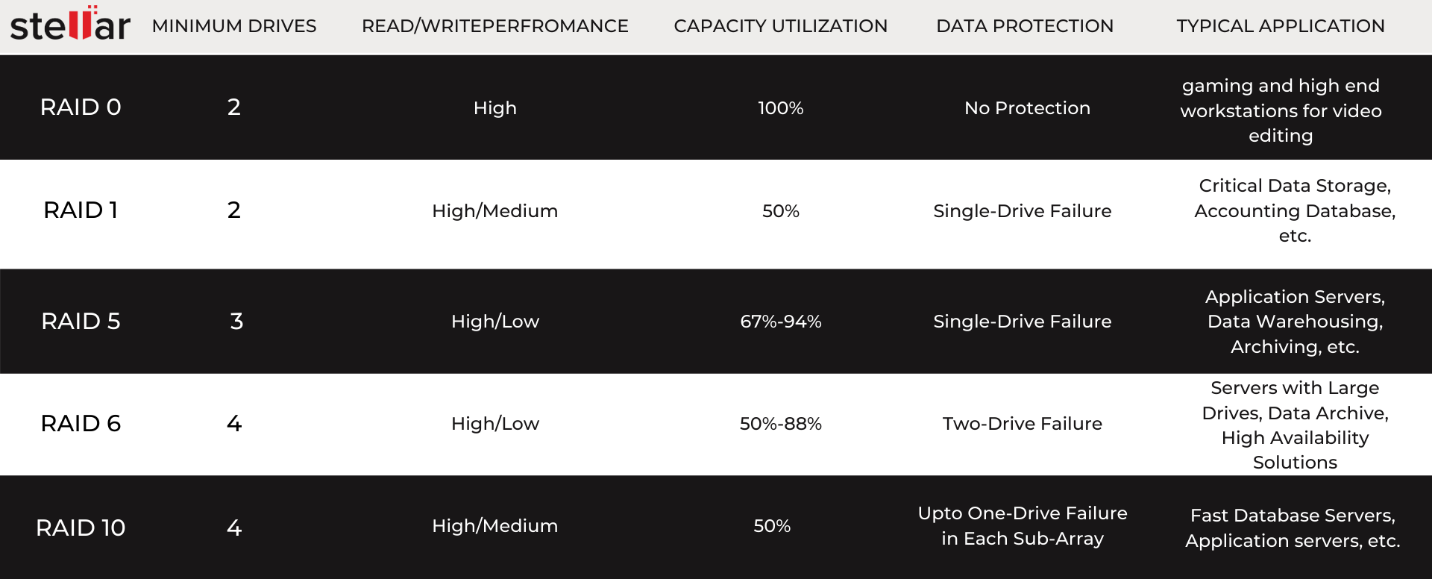RAID Level 0, 1, 5, 6, and 10 – With their Uses, Advantages, and Disadvantages
| Summary: Choosing a RAID level could be a cumbersome task, especially if it is your first. There are a number of advantages, disadvantages, and usage that each RAID level offers. In this post, we have discussed RAID 0, 1, 5, 6, and 10 levels in detail to help you understand and choose the best RAID level for your data storage and application needs. |
|---|
RAID or Redundant Array of Independent Disks is a logical arrangement of two or more physical drives which form one or more logical volumes. This logical arrangement of disks facilitates advantages such as data redundancy (fault-tolerance), higher read/write speeds, or both—over the traditional storage drives.
This post explains everything that you need to know about various RAID levels—RAID 0, 1, 5, 6, and 10—such as their advantages, disadvantages, and usage.
RAID Elements
To understand RAID levels, you must know about the fundamentals of RAID.
RAID has three basic elements, which are as follow:
1) Disk Striping – In disk striping, the data is divided into equal bytes, blocks, or partitions and spread across all the RAID member disks. This improves read/write speed.
2) Disk Mirroring – In disk mirroring, data replicates across all the member disks in a RAID level.
3) Parity – Parity is used in RAID levels such as RAID 5 and RAID 6 to achieve fault tolerance with improved read/write performance. The parity information is available across all the member drives. In the event of disk failure, the parity information is use to rebuild data.
Additional Reading : How to recover data from Raid 5?
Types of RAID
There are two types of RAID configuration,
1) Hardware-based RAID
In a hardware-based RAID, physical disks are connected to a RAID controller. This could be a dedicated PCIe RAID controller card or a motherboard RAID-On-Chip.
2) Software-based RAID
In software-based RAID, storage drives are connected to the motherboard and the RAID configuration is managed by the Disk Management utility provided by the OS.
How to Choose the Best RAID Level?
RAID 0, 1, 5, 6, and 10 are the most commonly used RAID levels. Each RAID level is discussed in detail to help you choose the best RAID level for your needs.
- Striping – RAID 0
- Mirroring – RAID 1
- Striping with parity – RAID 5
- Striping with double parity – RAID 6
- Combining mirroring and striping – RAID 10
RAID 0: Disk Striping
RAID level starts with RAID 0. It is the most basic RAID level that uses disk striping for data storage, hence offers faster I/O speeds. RAID 0 requires a minimum of two drives and is the most cost-effective RAID solution.
Advantages
- Faster read/write performance, comparable to SSDs
- 100% physical disk capacity is available for use
- Most affordable and easy to set up
Disadvantages
- No fault-tolerance
- If a disk fails, data is gone forever
Usage
- Gaming
- Video and Image Editing
- Non-critical data storage
RAID 0 is all about performance and storage capacity.
RAID 1: Disk Mirroring
It is the most basic RAID level that uses disk mirroring for data storage and provides fault-tolerance against a drive failure. It requires a minimum two drives and data is replicated. And since both drive stores the same data, the actual capacity drops to 50% of an actual physical disk volume.
For instance, if you have used two 2TB drives for RAID 1, the actual capacity will be 2TB, not 4TB.
Advantages
- Fault-tolerance—protects against data loss (up to one drive failure)
- Affordable and easy to set up
- No overhead
Disadvantages
- 50% of actual drive capacity
- Hot-swapping in software-based RAID 1 is problematic
Usage
- For mission-critical applications and data storage
- Storing and accessing accounting, video editing, or gaming data
RAID 1 is all about data protection and not performance.
RAID 5: Disk Striping with Parity
A RAID 5 requires a minimum 3 drives (maximum 32). It’s the most affordable RAID level that offers uses disk striping with the parity bit. Thus, provides fault-tolerance and balanced read/write performance.
RAID 5 can withstand up to one drive failure. In the event of a disk failure, RAID 5 rebuilds data blocks from the parity information.
Advantages
- Fault-tolerance, withstand single drive failure
- Balanced write but faster read performance
- Utilize up to 67%-94% of physical disk capacity
Disadvantages
- Data rebuild is slow and cause overhead
- Data loss If two disk fails
- Costly
Usage
- Data backups
- Application and file servers
- Archiving and data warehousing
RAID 6: Disk Striping with Double Parity
RAID 6 level is known as RAID 5 on steroids. It’s essentially an improved version of RAID 5 level that overcomes a major RAID 5 issue—the inability to survive more than 1 disk failure. It uses the same technique as RAID 5 but stores a parity bit in two disks.
Thus, RAID 6 can withstand up to 2-disk failure without data loss. It requires a minimum of 4 physical drives and the usable capacity is 50%-88% (max.) of the total disk volume.
Advantages
- Balanced read/write performance
- Up to 88% of physical disk capacity is usable
Disadvantages
- Data rebuild takes longer time
- A bit expensive than RAID 5
Usage
- File servers
- Critical data storage
- Data backup
RAID 10: Disk Striping and Mirroring
RAID 10 is a Nested-RAID level, which is created by combining RAID 1 and RAID 0 levels. Thus, it provides both fault-tolerance (RAID 1) and faster read/write performance (RAID 0).
It’s essentially a mirrored RAID 0 level, which requires a minimum of 4 storage drives.
It can withstand up to two-drive failure from a single side without data loss. However, data loss can happen if one drive from each side fails.
Similarly, one can also create RAID 50, RAID 60, or RAID 100 as per their data storage and application needs. However, Nested RAID arrangements are expensive and most users can’t afford it.
Advantages
- Faster read/write performance
- Fault tolerance, protection against up to two disk failure
Disadvantages
- If two disk from the either sides fails, then you have to compromise data
- 50% of total physical disk capacity
- Too costly
Applications (Use)
- Mission-critical task and data storage
- Database servers
RAID 0, 1, 5, 6, & 10 Level Comparison Chart

Conclusion
RAID helps reduce data loss and improve performance. However, RAID may fail, break, or stop working due to several logical and physical errors caused by virus or malware intrusion, human errors, disk errors, or failure, etc.
Therefore, it’s important to keep a backup of data stored on the RAID volume to avoid permanent data loss. Remember, RAID isn’t a backup or alternative to backup.
In the absence of backup or obsolete backup, you can reach out to a data recovery specialist for an expert solution and RAID data recovery. You may also use a DIY RAID data recovery solution such as Stellar Data Recovery Technician to rebuild a broken or corrupt RAID 0, 5, or 6 level and recover inaccessible data.








